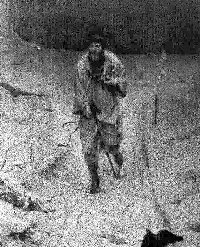Restor ed Master pieces

Some 100 unique works of art have been restored at the art and local history museums of Kirovohrad. Among these works are true gems, such as Pavel Svedomsky’s God’s Fool and the 18th century Cossack icon, Protective Veil of St. Paraskeva. Both will shortly be available to devotees of national art.
For years legends surrounded God’s Fool . But Pavel Svedomsky’s (1849-1904) piece was in terrible condition. No one saw it except the museum staff. The artist painted it in 1883, in Rome, based on work he did at his estate in Perm gubernia. Art critics who had seen the painting, compared it to similar “fools” painted by Perov and Surikov. They noted that Svedomsky’s work was the best of all Russian art of that period. The artist brought this work to Kyiv for an exhibit at the Stock Exchange Hall. He hoped to sell it to the noted Ukrainian philanthropist and art collector M.I. Tereshchenko. But he already had Vassily Perov’s God’s Fool , so Svedomsky presented it to art critic Adrian Prakhov. In 1967, his granddaughter, Olena Maziuk donated God’s Fool to the local museum of Kirovohrad.
The canvas was in a bad way even then, so it was never shown. The painting had been inadequately framed, was torn in many places, had abrasions, paint and first coat peeling, covered on both sides with sturgeon glue. Inadequate storage conditions, humidity, and temperature fluctuations aggravated the condition. Fortunately, eventually it was transferred to the regional art museum where it was restored.
The other restored masterpiece is the 18th century Cossack icon, Protective Veil. St. Paraskeva. Restorers chose it because it was 250 years old when they started their work. The museum received it from Oleksandr Ilyin, a noted local art collector. It is unique because it portrays two subjects, the Protective Veil of the Virgin Mary and a portrait of St. Paraskeva. There is an inscription on the reverse side: “This icon was restored by the brothers and sisters of the village of Petra-Ostrova, with the Father Vassily, in August of the year 1895.” There is another, older inscription, barely discernible, but the figure “1752” may indicate the date the artist painted it.
Both masterpieces were rescued thanks to the local state administration that included restoration subsidies in the regional 2002 socioeconomic development program and the regional museum development program through 2005. Authorities allocated UAH 30,000 for the restoration of Svedomsky’s canvas and UAH 4,000 for the Cossack icon. Tetiana Bychko and Anatoly Bezkrovny, both restoration experts at the National Restoration Research Center of Ukraine, were invited to Kirovohrad. They did an excellent job on both works. In fact they accomplished even more, restoring a seventeenth century patent with the red seal of Tsar Fёdor Alekseyevich, a mid-eighteenth century scroll of Yelizavetgrad, an eighteenth century military uniform, a nineteenth century plashchanytsia (used in Orthodox Churches to represent the burial shroud of Christ), Sofia Tobilevych’s clothes, also dating from that century, along with china, weapons from the eighteenth through twentieth centuries, and other objects.






